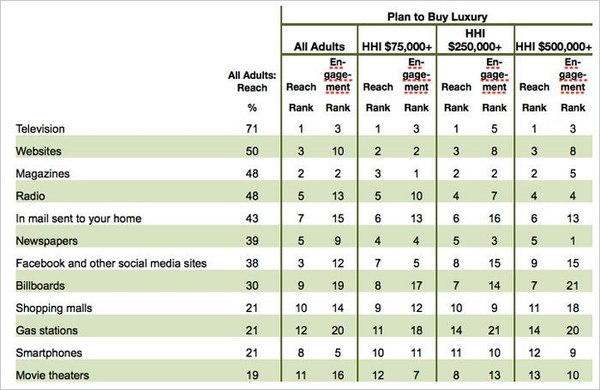3 Ways To Use Social Media To Target High-Net-Worth Consumers
Traditionally, marketers tend to segment their customers into either a B2B or B2C relationship. While this has worked for a long time, and will obviously continue to work, many high-net-worth consumers (who most likely also own or run businesses) must be treated differently when it comes to marketing with social media. In a recent survey […]
Traditionally, marketers tend to segment their customers into either a B2B or B2C relationship. While this has worked for a long time, and will obviously continue to work, many high-net-worth consumers (who most likely also own or run businesses) must be treated differently when it comes to marketing with social media.
In a recent survey conducted by the Shullman Research Center, CEO and owner Bob Shullman said:
“Consumers with a household income of $75,000 or more planning to buy luxury tend to pay more attention to advertising than all Americans do. They also appear to favor traditional print (magazines and newspapers), while digital channels (websites and social media) are also reaching a greater proportion of these valuable luxury prospects.”
Here are the results of that survey:

Another research study done by Google on luxury buyers (who spend, on average, $2,500 per purchase) concluded that more than two-thirds of them research the products online before they purchase.
Here are 3 ways to use social media to target high-net-worth consumers:
Social Media Tactic 1: News Jacking
This isn’t a new principle in marketing. But if you want your million-dollar prospects to notice your product, first you need to scan news headlines in their favorite publications — Forbes, Fortune, Inc., etc. — and see what’s being talked about in the Finance sections. Are there concerns about Syria and its effect on American markets? Craft a short Tweet or Facebook post with your take on the situation, using hashtags to insert yourself into the conversation: #syria, #economy, #stocks, etc.
Social Media Tactic 2: Create Researching & Buying Guide Videos
Affluent consumers, when researching their purchases, will wonder about what is going to make their lives the easiest in the long term. Which product is going to have the longest lifetime value? Which will enable them to best enjoy the leisure that their income affords them? Many lower price-point products, however, are not built to last in the same way, so non-affluent consumers are looking to get the best they can now.
With this in mind, it is powerful to create buying guides and comparison videos. According to the previous Google study, 45% of luxury buyers prefer to watch videos of products and how they are used or worn.
Social Media Tactic 3: Celebrity Status
If affluent prospects are incentivized through a suitable quid pro quo to give you their information online, you can give them the same treatment as when they roll up in a nice sports car “dressed to the nines.”
The benefit to you is that you can ask them questions like, “Do you make between 75-100k per year?” This helps you determine if a particular consumer is a digital “high roller” or not — which of course helps you qualify them as a solid lead.
But you do have to give them enough incentive in return to provide you that data. One thing that PPC management firm Webrageous does is provide their prospective clients with a free PPC audit after filling in a detailed submission form.
David Chapman, Marketing Director at Webrageous says:
“When a qualified prospect fills out our form or calls us we are always happy to review their account and see if there is a potential to improve it. Not only do we want to do this to help a client feel comfortable choosing us we almost insist on it and would be uncomfortable taking on a client if we didn’t know we could improve their results.”
Before that digital “high roller” even gets to your website, though, you need to be able to treat them like royalty in their research phase. Twitter and Facebook are good for this sort of thing, since you can make very specific calls-to-action that entice the high-net-worth individuals to respond.
For instance, @RobbReport tweeted this message out:
[Sponsored] @Inspirato gives a new meaning to oceanfront w/ their Water Villa: http://t.co/uOSpPB5Xh6 pic.twitter.com/bgHtsGrY8Q— Robb Report (@RobbReport) September 24, 2013
Inspirato happens to be a very exclusive American Express card reserved for luxury travelers. They obviously know who they’re targeting, so they used the Robb Report’s Twitter platform to send out a very specific message.
Now that social media has moved on from the Wild West days of buying as many Facebook fans as possible with no ROI, brands and marketers can use age-old principles, and new media, to target their affluent consumers even more cost-effectively than ever before.
Contributing authors are invited to create content for MarTech and are chosen for their expertise and contribution to the search community. Our contributors work under the oversight of the editorial staff and contributions are checked for quality and relevance to our readers. MarTech is owned by Semrush. Contributor was not asked to make any direct or indirect mentions of Semrush. The opinions they express are their own.
Related stories